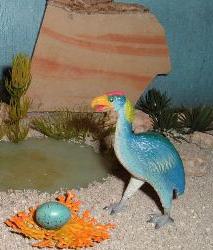From the Dinosaur Collector
The Paleocene 65 million years ago the dinosaurs became extinct and the Mesozoic ended. The Cenozoic is divided into two parts the Tertiary and the Quaternary. The Tertiary lasted 63 million years and continued the flora which began developing at the end of the Cretaceous. Flowering plants continued to develop but grasses are not wide spread. Forests are common. The climate is warm even in the polar regions. Conifers remain wide spread but the number of species are not numerous. Asia seems to have been cut off from Europe. Primates are wide spread looking like Lemurs and Wood chucks. The impression is of an ecology that favored browsers and arboreal animals. update 082107
The Paleocene must have been seemed empty after the Cretaceous. Pantadonts were a diverse order of browsing animals that thrived in the Paleocene dying out in the Eocene. They ranged from the size of rabbits to rhinos. Barylambda was one of the largest Paleocene mammals at around 650 kg. Its skeleton is of a cumbersome animal made for browsing by resting on its massive hind limbs and its heavy tail, which allowed to raise the front of the body and to brows the high branches. Their life style may have been like that of the extinct ground sloth.
Barylamba from the Nabisco prehistoric mammal premium made by Lido. These figures are quite good for there time and it is still one of the the best toy figures of an early mammal. This figure is often misidentified as a sloth or dire wolf. It appears to be based on the Zallinger Age of Mammals mural. Diatryma and Gastornis have attracted the public but not much else from the epoch has caught on the public attention.
In the Late Paleocene and Middle Eocene the 9ft tall Diatryma and its relatives dominated North America and Europe. They are alternately thought to have been the predators of the period or eaters of rushes and tussocks. Diatryma that used its beak to harvest foliage, fruits, and seeds from the subtropical forests that it inhabited, They and a rare terrestrial alligator seem to the best candidates for top predator in the first Paleocene. Mammals remain small. had relatively short legs did not have long talons, but rather short toenails
Diatryma from Bullyland.
Return to Cenozoic Menu
Click on the Site A icon left for more diorama listed by location Click on the Site A icon to the right for Dioramas organized by period or by manufacturer.
